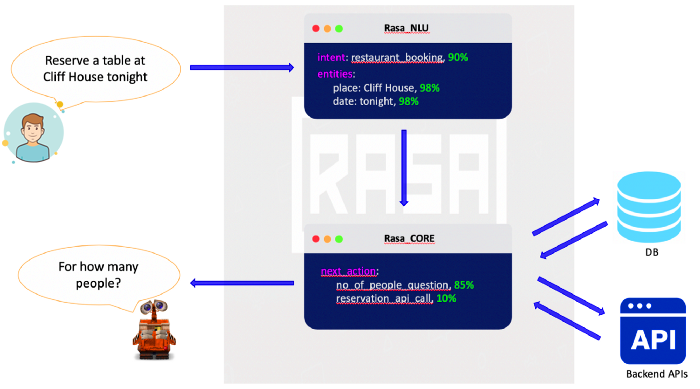It is quite a long time since I wrote my latest post, and now I come back stronger with a topic that contains both Back-end and AI. It is my journey to customize the Natural Language Understanding (NLU) testing process of the RASA platform to reduce the computation time. In other words, I applied batch prediction in the testing phase, which is currently not available in the pipeline. This post is probably long because I will list things that I modified, so please be patient and follow it until the end.
1. Technology
During the process, I only use Python, RASA (v3.1), and the Monkey Patching technique to customize the RASA package. For people who don’t know about Monkey Patching yet, it is a technique to edit attributes at runtime, it can also be used to override functions/methods in libraries.

RASA, on the other hand, is a famous platform to build chatbots that currently has 15k stars in its repository. It supports many NLP components to provide the pipeline having the best performance and high accuracy.

2. DietClassifier
As I read from the RASA source, each component in the RASA pipeline has two main methods: train and process. The train method will be used in the training process, and the process one will be used in the testing process as well as when running RASA servers. Therefore, our ultimate goal is to find out why the process method cannot run in batches and make adjustments to improve it.
Because the model is often the slowest one, I will check the DietClassifier class to make improvements for it first. Looking at the code link below, we can see that the process method receives a list of messages as the parameter and loops through it. So we only need to refactor the process method, don’t we?
https://github.com/RasaHQ/rasa/blob/3.1.x/rasa/nlu/classifiers/diet_classifier.py#L1018-L1021
Unfortunately, there is only one message inside the list after adding logging to that function. Therefore, I had to look for where it is called. After reading through many methods, I found out that the data is passed through these methods below first before going through process:
rasa.nlu.test.get_eval_data: receive a list of messages, loop through them, and call parse_message.rasa.core.processor.MessageProcessor.parse_message: pass each message to the above method and verify the result.rasa.core.processor.MessageProcessor._parse_message_with_graph: pass each message to the pipeline.
The third one is the culprit which sends only one message to the pipeline at a time. Therefore, we need to customize this one first.
a. rasa.nlu.test.get_eval_data
In the code below, I only loop through all of the text, convert its format into messages, and forward them into the MessageProcessor.parse_message function.
1
2
3
4
5
6
7
8
9
10
11
12
13
14
15
16
17
18
19
async def get_eval_data(processor: MessageProcessor, test_data: TrainingData) -> Tuple[List, List, List]:
"""
https://github.com/RasaHQ/rasa/blob/3.1.x/rasa/nlu/test.py#L1246-L1342
"""
# measure time
start_time = time.time()
...
should_eval_entities = len(test_data.entity_examples) > 0
# TODO: Pass all messages to the processor
messages = [UserMessage(text=example.get(TEXT)) for example in test_data.nlu_examples]
results = await processor.parse_message(messages, only_output_properties=False)
# End change
for i, result in enumerate(results):
# access to the example using the index
example = test_data.nlu_examples[i]
...
b. rasa.core.processor.MessageProcessor.parse_message
We still have a lot of work besides editing the get_eval_data method. You can see that the parse_message method only receives one message at a time, so we must customize it as well.
In this function, I only edited the first parameter’s name and looped through the result to verify the format (_check_for_unseen_features) when it gets returned.
1
2
3
4
5
6
7
8
9
10
11
12
13
14
15
16
17
18
19
20
21
22
23
async def parse_message(
self, messages: List[UserMessage], only_output_properties: bool = True
) -> Dict[Text, Any]:
"""
https://github.com/RasaHQ/rasa/blob/3.1.x/rasa/core/processor.py#L619-L646
"""
if self.http_interpreter:
parse_data = await self.http_interpreter.parse(messages)
else:
parse_data = self._parse_message_with_graph(messages, only_output_properties)
# TODO: parse_data before modifying returns only one item.
# Here I return multiple items and loop through them to modify
for item in parse_data:
logger.debug(
"Received user message '{}' with intent '{}' "
"and entities '{}'".format(
item["text"], item["intent"], item["entities"]
)
)
self._check_for_unseen_features(item)
return parse_data
c. rasa.core.processor.MessageProcessor._parse_message_with_graph
In this method, instead of wrapping around a message with a list, I passed all messages to the pipeline (containing multiple components). Then I retrieved the data using targets via the key self.model_metadata.nlu_target, looped through them, and edited the results.
1
2
3
4
5
6
7
8
9
10
11
12
13
14
15
16
17
18
19
20
def _parse_message_with_graph(
self, messages: List[UserMessage], only_output_properties: bool = True
) -> Dict[Text, Any]:
"""
https://github.com/RasaHQ/rasa/blob/3.1.x/rasa/core/processor.py#L648-L673
"""
results = self.graph_runner.run(
inputs={PLACEHOLDER_MESSAGE: messages}, # TODO: receive multiple messages and pass to graph_runner
targets=[self.model_metadata.nlu_target],
)
parsed_messages = results[self.model_metadata.nlu_target]
# TODO: loop through message and update them
for i, parsed_message in enumerate(parsed_messages):
parsed_messages[i] = {
TEXT: "",
INTENT: {INTENT_NAME_KEY: None, PREDICTED_CONFIDENCE_KEY: 0.0},
ENTITIES: [],
**parsed_message.as_dict(only_output_properties=only_output_properties)
}
return parsed_messages
d. rasa.nlu.classifiers.diet_classifier.DIETClassifier.process
Adjusting these methods above only opens the entry gate for batch processing, there is still a lot of work to do. In process, we can see that it gets the predictions from _predict and does post-processing.
https://github.com/RasaHQ/rasa/blob/3.1.x/rasa/nlu/classifiers/diet_classifier.py#L1018-L1039
There are a few approaches here:
- Modify the
_predictmethod to accept all messages and theself.model.run_inferencemethod will separate data into batches and do the batch prediction there. - Separate all messages into batches inside the
processmethod and directly callself.model.run_inference
I tried both approaches and found out that only the second one worked. The first approach is very intuitive but it doesn’t work because the predictions of many batches don’t share the same dimensions, so they cannot stack on top of each other. I could not figure out the root causes and I did not want to either because I am not the AI Engineer anymore (just a Back-end guy).
The second approach is not impossible, we only need to understand the below methods:
rasa.nlu.classifiers.diet_classifier.DIETClassifier._predict: It only creates theRasaModelDataobject so we obviously can move toprocess.rasa.utils.tensorflow.models.RasaModel.run_inference: It generates the data generator based on theRasaModelDataobject from the previous step, then does prediction concatenation (we have to skip this one because of what I mentioned earlier).
Therefore, here is the new run_inference method:
1
2
3
4
5
6
7
8
9
10
11
def RasaModel_run_inference(self, data: tuple) -> Dict[Text, Union[np.ndarray, Dict[Text, Any]]]:
"""
https://github.com/RasaHQ/rasa/blob/3.1.x/rasa/utils/tensorflow/models.py#L280-L322
"""
# data_generator is a tuple of 2 elements - input and output.
# We only need input, since output is always None and not
# consumed by our TF graphs.
batch_in = data[0]
# TODO: Inference a batch of data instead of one message. I also removed the data concatenation between batches
outputs: Dict[Text, Union[np.ndarray, Dict[Text, Any]]] = self._rasa_predict(batch_in)
return outputs
And the new process method is here, you can look at the description in the code. Note that we need to define a global BATCH_SIZE variable to easily change it.
1
2
3
4
5
6
7
8
9
10
11
12
13
14
15
16
17
18
19
20
21
22
23
24
25
26
27
28
29
30
31
32
33
34
35
36
37
38
39
40
41
42
43
44
45
46
47
48
49
50
51
52
53
54
55
56
57
58
59
60
61
62
63
def DIETClassifier_process(self, messages: List[Message]) -> TrainingData:
"""
https://github.com/RasaHQ/rasa/blob/3.1.x/rasa/nlu/classifiers/diet_classifier.py#L1018-L1039
"""
print("Run DIETClassifier process")
start_time = time.time()
# TODO: Chunk messages into multiple smaller chunks with BATCH_SIZE = 256
global BATCH_SIZE
# create RasaModelData just like what _predict does
model_data = self._create_model_data(messages, training=False)
if model_data.is_empty():
return messages
# separate the data into batches
(data_generator, _) = rasa.utils.train_utils.create_data_generators(
model_data=model_data, batch_sizes=BATCH_SIZE, epochs=1, shuffle=False
)
data_iterator = iter(data_generator)
message_counter = 0
total_messages = 0
while True:
try:
# TODO: pass batch of data to model.run_inference2 function and do post-processing here to
# ignore the result concatenation (if not, the concatenation will be handle in RasaModel_run_inference)
batch = next(data_iterator)
out = self.model.run_inference2(batch)
total_messages += len(out["diagnostic_data"]["attention_weights"])
# TODO: post-processing
while message_counter < total_messages:
message = messages[message_counter]
message_out = {
DIAGNOSTIC_DATA: {
"attention_weights": out[DIAGNOSTIC_DATA]["attention_weights"][message_counter % BATCH_SIZE],
"text_transformed": out[DIAGNOSTIC_DATA]["text_transformed"][message_counter % BATCH_SIZE],
},
} if out else None
if out and "i_scores" in out:
message_out["i_scores"] = out["i_scores"][message_counter % BATCH_SIZE]
if out and "e_entity_ids" in out:
message_out["e_entity_ids"] = out["e_entity_ids"][message_counter % BATCH_SIZE][np.newaxis, ...]
message_out["e_entity_scores"] = out["e_entity_scores"][message_counter % BATCH_SIZE][np.newaxis, ...]
if self.component_config[INTENT_CLASSIFICATION]:
label, label_ranking = self._predict_label(message_out)
message.set(INTENT, label, add_to_output=True)
message.set("intent_ranking", label_ranking, add_to_output=True)
if self.component_config[ENTITY_RECOGNITION]:
entities = self._predict_entities(message_out, message)
message.set(ENTITIES, entities, add_to_output=True)
if out and self._execution_context.should_add_diagnostic_data:
message.add_diagnostic_data(
self._execution_context.node_name, message_out.get(DIAGNOSTIC_DATA)
)
message_counter += 1
except StopIteration:
break
print(f"End DIETClassifier: {time.time() - start_time}")
return messages
e. Do Monkey Patching
1
2
3
4
5
6
7
8
9
10
11
from rasa.nlu import test
from rasa.core.processor import MessageProcessor
from rasa.nlu.classifiers.diet_classifier import DIETClassifier
from rasa.utils.tensorflow.models import RasaModel
test.get_eval_data = get_eval_data
MessageProcessor.parse_message = parse_message
MessageProcessor._parse_message_with_graph = _parse_message_with_graph
DIETClassifier.process = DIETClassifier_process
# run_inference will be used when starting the model, so we shouldn't monkey-patch it.
RasaModel.run_inference2 = RasaModel_run_inference
3. ConveRTFeaturizer
After customizing DIETClassifier, I recalled that the time was cut in half, but I had to wait for a long time to see the data passed to the DIETClassifier. Therefore, I kept investigating and found out that there is another bottleneck in ConveRTFeaturizer, this component also uses a third-party model. Therefore, we need to adjust this one too.
a. rasa.nlu.featurizers.dense_featurizer.convert_featurizer. ConveRTFeaturizer.process
In NLU, I only use TEXT key, so I skipped ACTION_TEXT. I only used a function to chunk the data and looped through each chunk.
1
2
3
4
5
6
7
8
9
10
11
12
13
14
15
16
17
18
19
20
21
22
23
24
def chunks(lst, n_chunks):
"""Yield successive n-sized chunks from lst."""
chunk_size = len(lst) // n_chunks
chunk_size = len(lst) if chunk_size == 0 else chunk_size
for i in range(0, len(lst), chunk_size):
yield lst[i:i + chunk_size]
def ConveRTFeaturizer_process(self, messages: List[Message]) -> List[Message]:
"""
https://github.com/RasaHQ/rasa/blob/3.1.x/rasa/nlu/featurizers/dense_featurizer/convert_featurizer.py#L379-L395
"""
print("Run ConveRTFeaturizer process")
# TODO: Chunk messages into multiple smaller chunks with BATCH_SIZE = 256
start_time = time.time()
global BATCH_SIZE
for message_chunk in chunks(messages, BATCH_SIZE):
attribute = TEXT
sequence_features, sentence_features = self._compute_features(message_chunk, attribute=attribute)
self._set_features(message_chunk, sequence_features, sentence_features, attribute)
print(f"End ConveRTFeaturizer: {time.time() - start_time}")
return messages
b. Do Monkey Patching
1
2
3
from rasa.nlu.featurizers.dense_featurizer.convert_featurizer import ConveRTFeaturizer
ConveRTFeaturizer.process = ConveRTFeaturizer_process
4. Run the new command
I mimic a part of all options that the rasa test command provides for some specific usage. Assume that the code is placed in the file run_new_test.py, here is how we can operate it.
1
2
3
4
5
6
7
8
9
10
11
12
13
14
15
16
17
18
19
20
21
22
23
24
25
26
27
28
29
30
31
32
33
34
35
36
37
38
39
40
41
42
43
44
# TODO Command:
# python run_new_test.py \
# --model models/model.tar.gz \
# --nlu data \
# --out results \
# --batch-size 256 \
# --no-plot
parser = ArgumentParser()
parser.add_argument("-m", "--model", type=str, default=get_latest_model(DEFAULT_MODELS_PATH))
parser.add_argument("-u", "--nlu", type=str, required=True)
parser.add_argument("-d", "--domain", type=str, default="domain.yml")
parser.add_argument("--out", type=str, default="results")
parser.add_argument("--batch-size", type=int, default=128)
parser.add_argument("--no-plot", action="store_true")
args = parser.parse_args()
BATCH_SIZE = args.batch_size
asyncio.run(
test_nlu(args.model, args.nlu, output_directory=args.out, domain_path=args.domain, additional_arguments={
"loglevel": None,
"model": args.model,
"stories": ".",
"max_stories": None,
"endpoints": "endpoints.yml",
"fail_on_prediction_errors": False,
"url": None,
"evaluate_model_directory": False,
"nlu": args.nlu,
"config": None,
"domain": args.domain,
"cross_validation": False,
"folds": 5,
"runs": 3,
"percentages": [0, 25, 50, 75],
"disable_plotting": args.no_plot,
"successes": False,
"no_errors": False,
"no_warnings": False,
"out": args.out,
"errors": True,
"func": run_nlu_test
})
)
5. Conclusion
I applied this code to my project and the time reduced significantly, around 60-80% for all models running on ~10MB datasets. I really enjoyed this task even though it seemed impossible at the beginning, the feeling is extremely like when I step out of my comfort zone.
That’s it. I could modify a small part of the RASA’s pipeline using my curiosity, AI Engineering, and Back-end knowledge. You can do that too by following these steps above and making the magic happens, good luck.